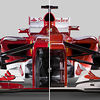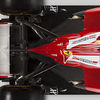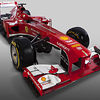Ferrari F138 launch - technical analysis
Ferrari presented its 2013 car in a big launch event at Maranello, with speaches from the main members from the team. The real star however was of course the new F138 which at first sight appeared to be a cautious development of the troubled F2012.
The most obvious changes of course include the removal of the step in the nose, as well as the oddly shaped front wing supports. But the differences go a little bit further than that.
The nose itself has been covered with a vanity panel to hide the step in the nose. Just as on the Ferrari F2012, it is almost as high as was possible within the rules as Ferrari again aim to maximise airflow underneath the car, as that is beneficial for rear end downforce, generated by the combination of the diffuser and the car's floor.
The nose also extends further ahead and is at least 5 cm longer than on the F2012. This is possibly done in combination with the forward extension of the upper part of the front wing pylons. This extension is only possible in the uppermost section, as that falls within the nose bodywork rules, whereas further down there is a restriction on the dimensions of the support. The pylons are again closer to each other at the rear, attempting to speed up the airflow in between them.
The front wing on the launched car is of a similar specification as the one raced by Fernando Alonso at last year's Brazilian GP. It features an almost completely flat base plane, a new feature that already was the result of Ferrari's development in the Cologne based wind tunnel from TMG, formerly the Toyota F1 Team.
The middle part of the car appears to be largely identical to its predecessor, with a similar cockpit opening, identical side protection structures around the helmet area and similar sidepod inlet shapes. The sidepod panels are also a version that was already raced in 2012.
The airbox inlet however is a little bit more round and has a slightly increased opening surface, allowing it to catch more air. With a similar engine in place, this is either a change to increase engine performance or to cool internal components that now need additional cooling. The extra inlet is also still present right behind the primary airbox inlet, catching air to cool the gearbox oil. It underwent only minor changes.
The rear end of the car is however where the most interesting changes happened. That should be no surprise given the issues the team had last year before it could get the coanda exhausts to work properly. The rear end was basically entirely redesigned, with the gearbox stretched out and made smaller in order to clean up airflow. The rear end of the sidepods are still similar to the Brazilian 2012 spec, but with a confirmed "entirely new exhaust layout", this is certain to change before or during winter testing.
Simone Resta, the leader of the F138 project confirms: "There were very few changes to the regulations, but nevertheless we chose to work on and modify all aspects of the car, trying to move forward in every area, because we felt there was a significant amount of performance that could be gained with this new car. I would say the biggest changes relate to the front suspension, which has an improved layout, while at the rear, the suspension is completely new. We also have a revised sidepod design, aimed at improving the aerodynamics in this area, as well as a completely new layout for the exhaust system."
Together with this rear end cleanup, the rear suspension was also entirely revised. The lower rearward wishbone has been aligned with the driveshaft into one carbon fibre shell, reducing drag and preventing the rotating drive shaft from influencing the airflow where it is most critical. Another interesting change is the positioning of the pull rod. While it previously ran down from the upright to a point in the chassis in between the lower wishbones, it now runs down ahead of all wishbones, as already seen on the Red Bull RB8 and the Williams FW34. Again, this is part of the cleanup, as the pull rod attachment point is now moved out of the way of the exhaust flow. Red Bull style strakes have also been added above the diffuser to improve airflow direction.
Finally, the rear wing is new, with a lot of gills in the endplates, fins at the bottom of the endplates and two slits at the trailing edge. Here the designers are trying to extract as much air as possible from in between the endplates, reducing pressure in that area and (slightly) increasing downforce generated by the rear and beam wings.
Perhaps the most important changes have happened underneath the skin, as comments from the team itself reveal several improvements: "As for the electronics, it is worth noting the introduction, ahead of schedule, of the single control unit that will be used in 2014. This has involved a lot of work to integrate and control all its features in terms of both software and hardware."
This points out that Ferrari have chosen to immediately use the TAG-320 ECU which offers greater performance without increased dimensions. It is actually designed to be able to copy with the 2014 powertrains, but nobody stops teams from using it in 2013 as well.
Meanwhile Corrado Lanzone, head of production at Ferrari pointed at another focus point in the development of the F138: "When it came to the F138 our two priorities were weight reduction and miniaturisation. Whenever rules remain unchanged the engineers concentrate their efforts on weight reduction, weight distribution and producing components to the very highest feasible level. This means confronting many challenges on the production side, putting us on the technological cutting edge in these areas of weight reduction and miniaturization of the components. The production stage is when it is vital to get this work done correctly, because while it is relatively simple to change the shape of external parts of the car during the season, it is a harder task when it comes to the core components. Miniaturisation, especially at the rear end of the car, allows us to come up with designs of aerodynamic components which give us a gain in terms of aero efficiency points and, eventually, in lap time."
As ever, however, Simone Resta confirmed that the car to be raced at Melbourne will be considerably different from the F138 that was launched: “The car we will race in Melbourne will be quite different to the one seen at the launch and the first test. In the past few weeks we have improved and indeed in those ahead of us now, we can improve further, the performance of the car, which guarantees that the F138 in Melbourne will be significantly different to the F138 at Test 1…and hopefully quicker. I am reasonably happy with the car so far as there was a significant performance gap to be closed, something which we cannot deny, but I think we have done a good job in all areas, trying to cover all the weak points of its predecessor.”








